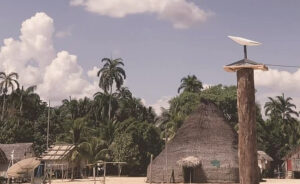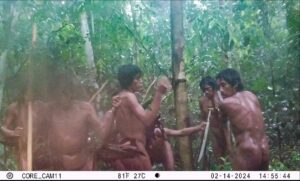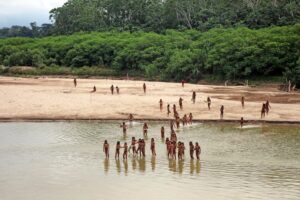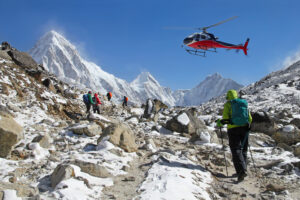This time the Amazon enchanted the Italian photographer, Gabriele Croppi. Photographs he took during his journey portray a story about a river, a region, the people, and about himself.
Amazon in black and white
By Piotr Chmieliński
This time the Amazon enchanted the Italian photographer, Gabriele Croppi. Photographs he took during his journey portray a story about a river, a region, the people, and about himself. As he admits, the expedition was a kind of experiment, carried out without excessive expectations and detailed plans. “I see this journey as something organic,” he said, “a powerful experience that consists of many different aspects.”
Photo 1. The silhouette of a man in a background of the clear sky looks like it was cut out from a photograph and only a black contour left behind. Similarly, the Ver-o-Peso building, the largest fish market in South America. This distinctive shape and the high-rise skyscrapers allow you to guess that the photograph was taken in Belém, a Brazilian port at the mouth of the Amazon River to the Atlantic. At that place most of the explorers finish their Amazon expeditions but Gabriele began his photographic journey up the world’s largest river, to its source.
It was not a record-setting expedition, it was not a typical tourist trip either. Its purpose was to capture in the picture frame the spirit and “charisma” of the queen of rivers, by photographing people, places, phenomena. Gabriele was moving around the Amazon area using public transportation. First, the vessels seemed as big as the river that was spilling over – the passenger-cargo ships. The further up, with narrowing riverbed and faster water current, the boats were smaller and smaller. Sometimes it was a little ship, sometimes a paddleboat, sometimes a peke-peke which is Peruvian motorboat. The final stage in the mountain, he walked or used horses and mules. He did not sleep in luxury hotels, only in a hammock, sometimes in a tent, sometimes in a hostel or in the hospitable homes in the villages he visited.
Photo 2. The smooth surface of almost ink colored water interrupts the movement of a small boat, in which a man sits, deep into the Amazon. The sharp blacks on the shoreline are trees, bushes, and grasses. And in the sky, gray – from graphite to light gray, even silver – interlaced with highlighted white. Still, the whole picture is almost dark. Almost, because at the left end the bright glow flows from the sky to a tiny part of the river. Captured as if by accident, barely in the frame. And yet – a hardly perceptible swirl of the river, strongly influences the imagination, which already sees the images of a powerful, unpredictable and immediately delightful river, the Amazon.
Why did the photographer choose the Amazon? According to Gabriele, Amazonia is still perceived as one of the largest uncharted regions of the earth with the most inaccessible river flowing through its center. A river that awakens fascination and is surrounded by peculiar “myths” and legends depicted in the literature since the very first explorations. Explorers have been fostering dreams of discovering the Amazon, and even conquering her, for centuries. Gabriele says “Amazonia is one of the few places in the world where modernity, speed, and ease of communication have failed to eliminate this myth, still alive in the social imagination, manifested in the existence and beliefs of indigenous tribes, and legends about the Amazons and El Dorado. Globalization has not killed the dreams that push people on the journeys held in a pioneering spirit, in a way not much different from the first expeditions. I would even say that Amazonia is still pristine in some respects. It allows travelers and readers to find a richer and better world by doing what the locals have done since the dawn of history – simply by traveling across the river! ”
The Amazonia and the Amazon River, which are spiritually immersed in the old unchanging ways, is reminiscent in many respects to the photographs of Croppi. This combination may explain the artist’s preferred black-and-white composition of images that he captures in the camera’s lens. As the photographer explains: “There are currently two trends in black and white photography. On the one hand, taking black and white photos is trendy, which can be linked to the quest for aesthetics and vintage culture. In my opinion, this is rather a superficial phenomenon that will disappear, and then it will come back, as it has often been in the history. On the other hand, black and white photography, due to its predisposition to abstraction or rather to assimilate to something different from reality, facilitates the approach, in which photography is not merely an instrument of objective documentation. It is rather an instrument of interpretation or subjective analysis of the fragment of reality in which we live. ”
Photo 3. A river is enclosed within the boundaries of thick vegetation. On the water are boats and a small wooden deck, but the main characters of this picture are two children jumping into the water. Their attitudes and gestures indicate a happy and carefree play. This is one of Gabriele’s favorite photos. It was taken on Río Salimões, as Brazilians call the Amazon above Manaus. The Aiucà tribe inhabits the photographed place. “This picture presents the Amazonian space, the relationship between man and the environment,” says Gabriele. “It also embodies the ‘Amazon’s time’, that is, that moment just before sunset when the day is over and when people come to the river, which gives them the life and wealth offered by nature.
Photos 4 and 5. The first is a portrait of an indigenous woman, a profile of the face of a beautiful young woman. Her head is decorated with feathers and her face marked with signs. Eyes closed, she seems to be lost in meditation, as if in her thoughts she is speaking to the spirits of her ancestors. This picture Gabriele took in the Brazilian village of Parintins. The next photograph depicts the opposite end of the timeline connecting the past with the present. The previously described woman embodies history, traditions, and distant times. The present is an image of people in contemporary clothes, standing, sitting, embracing, and talking on a deck entering slightly into the river. Most of them look at the river. Probably they are waiting for a ship to Belém or Manaus. Maybe they just look amazed at the Amazon? Maybe, the river makes them long for the far world. Maybe, they think of a trip to a large city and its attractions. Maybe filled with excitement, because they will soon meet with loved ones they have not seen for some time.
The people – natives and strangers, who quickly stopped being strangers – are the main heroes of Gabriele’s photographs. As he emphasized, he was looking at them not only through the lens of his camera, but above all, through the prism of stories they narrated and their reactions to his stories. “I met many unusual people, but I did not always capture them in a photograph,” says the traveler. – Photography responds to aesthetic impressions, and sometimes, important human experiences are not interesting from a photographic point of view. One such person was, for example, Lucho Hurtado of Huancayo, whom I met in the Mantaro Valley. He was in love with that area and made me discover real Peru, in addition to the carnival period. Lucho is a wonderful man whom I “photographed” only with my mind, but he will remain in my memory much more vividly, than many portrayed figures.
Photo 6. The jungle – palm trees and banana trees. Although in black and white, I would like to say that the image sinks in lush green. In the photograph, Gabriele is stretching a bow. Next to him stands the Ashaninka Indian, whose face and hand gestures appear to indicate a lack of faith in the accuracy of the gringo’s shot. Although in fact, the body language of a person can be read very subjectively. “During the trip I had a great time when I let the guides, the shepherds, and the people I met accidentally, take pictures with the small cameras I had with me. It was an interesting way to exchange knowledge and skills.Gabriele recalls. – “I tried to teach them how to take photographs. And there was no problem, because everyone was very interested and somehow fascinated with the technology I was familiarizing him or her with.” The effects of teaching the natives about the art of photography was surprisingly successful, making it possible for the visitor to see the various corners of the Amazon.
Photo 7. Raw landscape, consisting of smaller and larger mountains, covered with snow or completely stripped, some grass residues protruding through the stones. But it is only a background, because the photograph shows a high rock with gushing water and beside it is a man in joyful rapture with a bottle in his hand. What is the reason for Gabriele’s joy? Undoubtedly, it is the first touch of water coming from the source stream of the Amazon River, the Carhuasanta torrent. As one can imagine, this water was supposed to fill the bottle held by a man. The place reached by Gabriele is one of several Carhuasanta diverts and is considered by many to be the source of the river. However, the real source is located a little further up, in Lake Ticlla Cocha, where the traveler set out to realize the actual purpose of his trip.
Climbing up to 5142 meters above sea level, where the source of the largest river in the world is situated, Gabriele was thrilled by the mountainous stretch of this section of the river. Not only the enormity and height of the Andes, but also the different photographic conditions in comparison to the lowland were fascinating. “I’ve seen the landscapes of the lower Amazon before, because I lived in Brazil and Colombia for some time,” says the traveler. – The Andes were something completely different. I also liked that they were so different from the Alps where I grew up. I stepped into these mountains at ‘the worst’ time, during the rainy season. This gave me the opportunity to work with flashlights and be challenged with weather conditions that were technically more difficult, but more suggestive. I think the mountains are more interesting when it is misty, rainy, and snowy rather than on a beautiful sunny day. ”
Photo 8. It is impossible not to feel the icy cold when looking at this photograph. This impresses with the view of the snow covering the slopes of the mountains and the top of Nevado Mismi and the characteristic gaps of the itchu grass, frozen like the water spilling between them. A little more on the back is a pane of shimmering light. This is Ticlla Cocha, a permanent source of the Amazon. Here Gabriele Croppi ended his four-month trip from the estuary to the source of the Amazon, where, as in other recent Amazon expeditions, I participated – albeit at a distance – advising, supporting, cheering and following the progress of the Italian photographer. Gabriele is rich not only in photographs, but also in stories and experiences. Now he is dreaming of presenting them in the form of a book and a photographic exhibition.
More photos of Gabriele’s travel and interviews at www.slowing.co
Translation from Italian: Andrea Chmielinski
Bigazzi
For previous story please check:
https://explorersweb.com/Special-Pictures-from-the-Amazon-by-Gabriele-Croppi-2016-12-27-30902
https://explorersweb.com/quotOldquot-Amazon-in-pictures-by-Gabriele-Croppi—Part-2-2017-01-06-69488






